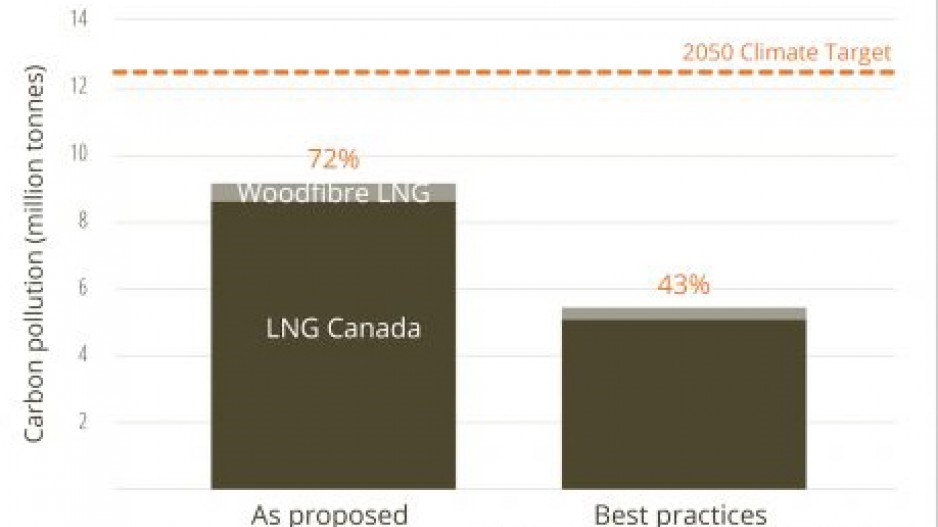No project the size of LNG Canada is without environmental impacts. But compared with the Trans Mountain pipeline, or even the now-dead Pacific NorthWest LNG project, the LNG Canada project has not generated the same level of concern among environmentalists.
The main environmental argument against the $40 billion project is the greenhouse gases it would produce.
Prime Minister Justin Trudeau and Premier John Horgan last week argued that there would be a net environmental benefit if lower-carbon liquefied natural gas (LNG) from Canada displaces coal power in Asia.
It’s an argument that could have merit, said Chris Bataille, an energy and climate policy researcher at Simon Fraser University.
“There is a strong argument for substitution of LNG for Chinese coal, or even a lot of other markets over there,” Bataille said. “And there is an argument they will get the LNG wherever they can.”
For any large LNG project in B.C., there are four main areas of environmental concern:
•disturbance to habitat, water and wildlife from the construction of a 670-kilometre pipeline from northeastern B.C. to Kitimat;
•increased hydraulic fracking;
•increased marine traffic; and
•greenhouse gas (GHG) emissions from upstream natural gas wells and an LNG plant.
Concerns over LNG tanker traffic impacts on killer whales have not been raised with the LNG Canada project the way they have with the Trans Mountain pipeline.
There is less marine traffic in the region compared with the southern coast, and unlike the southern resident killer whale, which is declining in number, northern resident killer whale populations have been growing.
It’s the project’s GHG profile that poses the biggest concern for environmental groups, the Pembina Institute and BC Green Party Leader Andrew Weaver.
LNG is made by chilling natural gas to -162 C into a liquid in processors called trains. The chilling process is typically done using natural gas as a power source.
The project’s first phase – a two-train plant – would produce 12 million tonnes per annum (Mtpa) of liquefied natural gas, requiring 1.8 billion cubic feet (bcf) of natural gas per day. The second phase – an additional two trains – would double the LNG production to 24 Mtpa.
There is some debate over how many GHG emissions that will generate.
The B.C. government estimates the project’s GHG emissions at 3.5 million tonnes of CO2 equivalent (Mt CO2e) – 2.1 Mt of which would come from the plant. That is based on a two-train plant.
The Pembina Institute estimates the project’s GHGs at more than twice that amount: 8.6 Mt CO2e in 2020 and 9.6 Mt CO2e by 2050, based on four trains.
Based on the Pembina Institute’s numbers, Weaver said the LNG plant can’t fit in B.C.’s climate action plan, at least not without draconian reductions everywhere else in the economy.
Horgan disagrees, although he concedes that the rest of B.C. may have to tighten its carbon belt.
“It will be significantly challenging for all of us,” he said last week. “But with the revenue – some $23 billion – coming to the province from the project, we will be able to innovate. We will be able to work with renewables, work with Shell and the joint venture partners to drive down emissions over the long term.”
According to the B.C. Climate Action Secretariat, the Pembina Institute assumed a 100% incremental increase in natural gas production to feed the new plant. The B.C. government factors in only a 60% increase.
Its reasoning is that about 40% of the gas feeding the plant will be from existing natural gas production. In other words, gas that’s already being produced would divert from other markets, so the emissions from that existing production should not be counted against the LNG Canada project.
Also, gas from the Montney region, where most of the gas that would feed the plant would come from, has a comparatively low carbon content to start with, compared with gas from Horn River and other areas.
The provincial government’s calculations also include reduced emissions resulting from electrification of the gas sector via the Dawson Creek and Chetwynd Area Transmission Line project. This fall, the BC Oil and Gas Commission will introduce new regulations requiring a 45% reduction in fugitive methane emissions.
Partly because it will use hydroelectricity from BC Hydro for ancillary purposes, the LNG Canada project is said to have the lowest emission intensity of any large LNG plant in the world.
Ultimately, while the LNG Canada plant will increase B.C.’s – and Canada’s, emissions – Prime Minister Trudeau said a significant reduction will result in Asia, where it is presumed LNG will displace coal power, especially in China.
“There’s a genuine question of weighing global costs and benefits and local costs and benefits here that needs to be looked at very closely,” Bataille said.
Reducing fugitive methane emissions and implementing carbon capture and electrification in the gas fields could result in ultra-low-carbon LNG, he said. Using electric drive for the liquefaction process would also lower a plant's GHG profile, he said. Because countries like China will buy LNG from someone, buying low-carbon LNG from Canada makes some sense.
“If one added all these elements, what you’re starting to do is explore what it means to be a low-carbon petrochemical industry,” Bataille said.
See related story, LNG decision hailed as epic investment in BC economy




